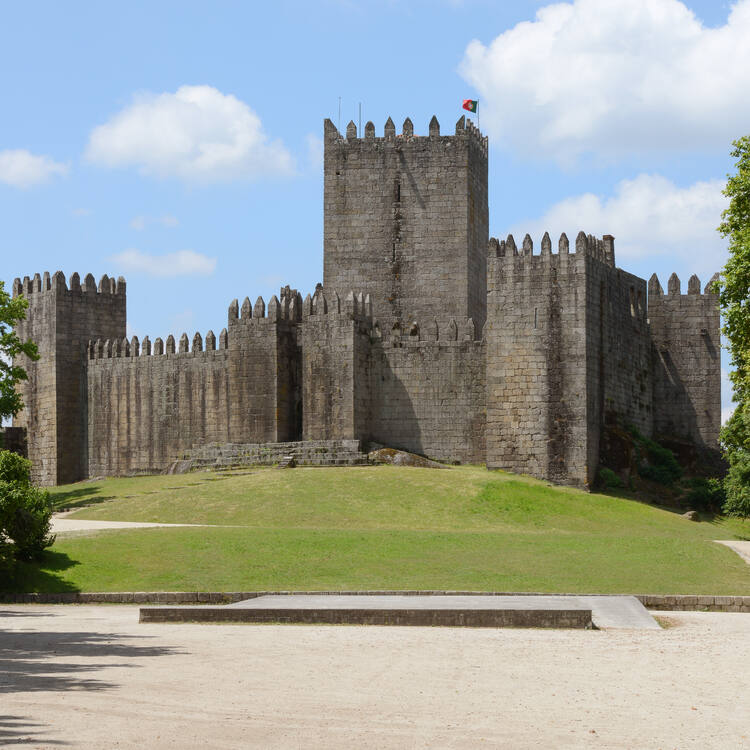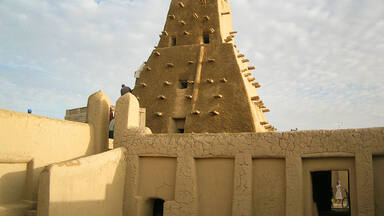Historic Centre of Guimarães and Couros Zone
Historic Centre of Guimarães and Couros Zone
The historic town of Guimarães is associated with the emergence of the Portuguese national identity in the 12th century. An exceptionally well-preserved and authentic example of the evolution of a medieval settlement into a modern town, its rich building typology exemplifies the specific development of Portuguese architecture from the 15th to 19th century through the consistent use of traditional building materials and techniques. The property includes two monastic complexes and an industrial area, the Couros Zone, which, like the local river, was named after the traditional craft of leather tanning. Evidence of the craft, though no longer practiced, persists in the form of tanneries, workers' houses and urban spaces from the 19th and early 20th centuries. The property bears witness to a thousand years of Portuguese urban, architectural and societal developments.
Description is available under license CC-BY-SA IGO 3.0
Centre historique de Guimarães et zone du Couros
La ville historique de Guimarães est associée à l'émergence de l'identité nationale portugaise au XIIe siècle. Exemple exceptionnellement bien préservé et authentique de l’évolution d'une ville médiévale vers une ville moderne, sa riche typologie de bâtiments illustre le développement spécifique de l'architecture portugaise du XVe jusqu’au XIXe siècle, grâce à l'utilisation cohérente de matériaux et de techniques de construction traditionnels. Le bien comprend deux complexes monastiques et une zone industrielle, la zone de Couros, qui, comme la rivière locale, a été nommée d'après le métier traditionnel du tannage du cuir. Les traces de ce métier, bien qu'il ne soit plus pratiqué, persistent sous la forme de tanneries, de maisons d'ouvriers et d'espaces urbains datant du XIXe et du début du XXe siècle. Le bien témoigne de mille ans d'évolution urbaine, architecturale et sociétale du Portugal.
Description is available under license CC-BY-SA IGO 3.0
وسط غيماراييس التاريخي ومنطقة كوروس
source: UNESCO/CPE
Description is available under license CC-BY-SA IGO 3.0
吉马良斯历史中心与库鲁斯区[拓界
source: UNESCO/CPE
Description is available under license CC-BY-SA IGO 3.0
Исторический центр города Гимарайнш и район Курос
source: UNESCO/CPE
Description is available under license CC-BY-SA IGO 3.0
Centro Histórico de Guimarães y Zona de Couros
source: UNESCO/CPE
Description is available under license CC-BY-SA IGO 3.0
Outstanding Universal Value
Brief synthesis
Founded in the 10th century CE, the Historic Centre of Guimarães became the first capital of Portugal in the 12th century. Its historic centre, including its extra muros area known as the Couros Zone, is an extremely well-preserved and authentic example of the evolution of a medieval settlement into a modern town, its rich building typology exemplifying the specific development of Portuguese architecture from the 15th to the 19th centuries through the consistent use of traditional building materials and techniques. This variety of different building types documents the responses to the evolving needs of the community, both for residential and proto-industrial purposes. There was developed a particular type of construction in the Middle Ages featuring a ground floor in granite with a half-timbered structure above. This technique was transmitted to Portuguese colonies in Africa and the New World, becoming their characteristic feature.
The Historic Centre of Guimarães and Couros Zone is distinguished in particular for the integrity of its historically authentic building stock. Examples from the period from 950 to 1498 include the two poles around which intra muros Guimarães initially developed; the castle in the north and the monastic complex in the south. The town expanded extra muros around the Franciscan and Dominican monastic complexes. The period from 1498 to 1693 is characterised by the building of grand houses, the development of civic facilities and the layout of city squares. While there have been some changes during the modern era, the Historic Centre of Guimarães and Couros Zone have maintained their medieval urban layout. The continuity in traditional technology, the maintenance and gradual change have contributed to an exceptionally harmonious townscape.
Criterion (ii): Guimarães, with its proto-industrial Couros Zone, is of considerable universal significance due to the fact that specialised building techniques developed there in the Middle Ages were transmitted to Portuguese colonies in Africa and the New World, becoming a characteristic feature.
Criterion (iii): The early history of Guimarães is closely associated with the establishment of Portuguese national identity and language in the 12th century. The Couros Zone bears witness to the wealth that independence brought to Guimarães and that made possible its continuous and harmonious urban and architectural development until the end of the 19th century.
Criterion (iv): The Historic Centre of Guimarães and Couros Zone is an exceptionally well-preserved town that illustrates the evolution of particular building types from the medieval settlement to the present-day city, and particularly in the 15th–19th centuries.
Integrity
The boundaries of the Historic Centre of Guimarães and Couros Zone encompass all the elements necessary to express its Outstanding Universal Value, including a particular type of construction developed in the Middle Ages using granite combined with a timber-framed structure, and a well-preserved historic building stock that represents the evolution of building typologies from the Middle Ages to the 19th century. This development is documented in the rich variety of different building types that have responded to the evolving needs of the community for residential and production purposes. The Historic Centre of Guimarães does not suffer unduly from adverse effects of development and/or neglect, whilst the Couros Zone needs an urgent conservation and rehabilitation strategy. Development pressures and gentrification related to tourism pressures may undermine, over time, the integrity of the property.
Authenticity
The Historic Centre of Guimarães and Couros Zone is authentic in terms of its location and setting, forms and designs, and materials and substances. It has succeeded in preserving its historic stratigraphy and territorial integrity. Different phases of development are well integrated into the layout of the property.
Protection and management requirements
The Historic Centre of Guimarães and Couros Zone is subject to several legal provisions regarding the protection of historic buildings, including Law No. 107/2001 of 8 September, Decree-Law No. 115/12 of 25 May, and Decree-Law No. 309/09 of 23 October, and to legal provisions regarding town planning, including Decree-Law No. 38 382 of 7 August 1951, Decree-Law No. 555/99 of 16 December, Decree-Law No. 307/2009 of 23 October. Its master plan, which dates from 1994, revised in 2015, includes regulations for the protection of the historic centre. The Historic Centre of Guimarães and Couros Zone includes nineteen properties that are legally protected as National Monuments (ten) or as properties of Public Interest (nine), according to the Portuguese Law on the Protection of Historic Monuments. Apart from some State-owned properties, most of the building stock is privately owned. The public areas of the historic centre are the property of the Municipality of Guimarães.
Parts of the buffer zone established for the property and its extension remain outside the protection zone. Whilst norms for the protection of the historic centre exist and a designation as National Monument is about to be approved for the Historic Centre of Guimarães and the Couros Zone, these have not been established for the buffer zone.
Management of the historic centre is the responsibility of the Municipal Division for the World Heritage and Listed Properties (DPMBC). Any intervention related to listed buildings is under the control of the Directorate General for Cultural Heritage (DGPC). Sustaining the Outstanding Universal Value of the property over time will require preparing, approving, and implementing the required norms and regulations for the extended property and buffer zone based on the attributes of Outstanding Universal Value. A Heritage Impact Assessment approach integrated into urban planning, and the rehabilitation strategy for the Couros Zone are essential for safeguarding the attributes of Outstanding Universal Value in the highly dynamic urban environment of Guimarães.

 View photos from OUR PLACE the World Heritage collection
View photos from OUR PLACE the World Heritage collection

